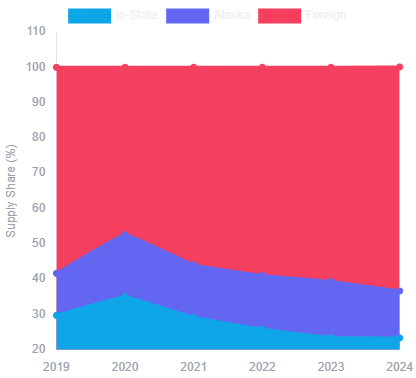
This exclusion stems from a technicality known as the “fast carbon cycle,” which assumes forests will quickly reabsorb the released carbon. However, with longer fire seasons and degraded ecosystems, this assumption is increasingly unreliable, potentially masking the true scale of California’s climate impact.
The problem is compounded by decades of horrific land management practices that have turned California’s forests into tinderboxes. For over a century, aggressive fire suppression policies—rooted in a desire to protect timber resources and human developments—have prevented natural, low-intensity burns that historically cleared out underbrush and dead wood.
This has led to massive fuel accumulation, with overcrowded forests now harboring up to 10 times more trees per acre than in pre-settlement times.
Are you from California or New York and need a tax break?
Federal lands, which make up a significant portion of California’s wildlands, have been particularly neglected, creating conditions ripe for catastrophic megafires.
Reports from bodies like the Little Hoover Commission have documented this mismanagement, noting that neglect has resulted in overgrown, unhealthy forests vulnerable to pests, drought, and ignition sources like power lines and human encroachment.
While Governor Gavin Newsom has ramped up investments in forest thinning, prescribed burns, and firefighting—allocating billions in recent budgets—these efforts come after years of inaction, and critics argue they’re still insufficient to reverse the damage.
Expansion into the wildland-urban interface has only heightened risks, as developments bring more ignition points into fire-prone areas.
Bad water management has further fueled this crisis, turning droughts into amplifiers for wildfires. California’s water system, a complex network of reservoirs, aqueducts, and groundwater basins, has been plagued by outdated infrastructure, competing demands from agriculture, urban users, and environmental protections, and a failure to adapt to climate-driven extremes.
Prolonged droughts—exacerbated by climate change—have weakened trees, making them susceptible to bark beetle infestations that kill millions of acres of forest, adding even more dry fuel.
Mismanagement, including over-allocation of water rights and insufficient storage capacity, has led to depleted reservoirs and earlier snowmelt, leaving landscapes parched during peak fire season.
For instance, policies prioritizing water diversions for endangered species in the Sacramento-San Joaquin Delta have been blamed for reducing supplies to farms and cities, indirectly contributing to water scarcity that heightens fire risks.
Wildfires, in turn, degrade water quality by dumping ash, sediment, and toxins into watersheds, creating a vicious cycle that strains municipal systems and increases erosion.
Experts warn that without major reforms—like modernizing infrastructure and better balancing ecological and human needs—California’s water woes will continue to stoke its fire problem.
Adding to the irony, California’s energy hypocrisy is on full display when examining its reliance on imported oil and fuels. Despite banning new fracking permits and phasing out in-state production, the state imports over 60% of its crude oil from foreign sources, with 2024 figures showing foreign imports at 324 million barrels annually, or 63.5% of total supply.

Major suppliers include Ecuador, Saudi Arabia, and Iraq, which together account for a substantial portion of these imports, historically around 70% when including other OPEC nations and countries like Colombia and Brazil.
Russia was a notable source until the 2022 U.S. ban following the Ukraine invasion, providing about 6% (18 million barrels) in 2021 alone.
These imports often come from regions with lax environmental standards, undermining California’s green image while exposing it to geopolitical risks. The dependency extends to refined products. California’s refineries, hampered by strict regulations and occasional outages, can’t keep up with demand, leading to surging imports of gasoline and diesel. In May 2024, fuel imports hit 279,000 barrels per day—the highest since June 2021—with gasoline and alkylate coming from as far as India (39,000 bpd in May 2025).
Overall, gasoline imports fluctuated, with December 2023 at 1.3 million barrels monthly.
Diesel imports are also rising, particularly renewable diesel, with 18,000 bpd arriving in Los Angeles in early 2024, part of a broader trend where imports make up a fifth of biomass-based diesel supply.
Statewide, diesel sales reached 3.5 billion gallons in 2024, with increasing reliance on imports to fill gaps.
Is this hypocrisy?
Absolutely. California touts its climate leadership, yet it offloads emissions to foreign oil producers while ignoring the massive carbon footprint of its wildfires. By excluding wildfire emissions from official inventories, the state risks greenwashing its progress, even as events like the 2020 fires release CO₂ equivalent to global cement production fractions.
Importing oil from countries like Ecuador and Iraq—nations with questionable environmental records—while curbing domestic production only shifts the pollution elsewhere. Coupled with land and water mismanagement that perpetuates fires, this reveals a policy blind spot: true sustainability requires accountability at home, not just virtue signaling abroad.
To break this cycle, California must integrate wildfire emissions into its climate goals, overhaul forest and water management with aggressive fuel reduction and infrastructure investments, and rethink its energy strategy to reduce import dependence. Without these steps, the Golden State’s green ambitions will continue to go up in smoke.
Is Oil & Gas Right for Your Portfolio?
Crude Oil, LNG, Jet Fuel price quote
ENB Top News
ENB
Energy Dashboard
ENB Podcast
ENB Substack






